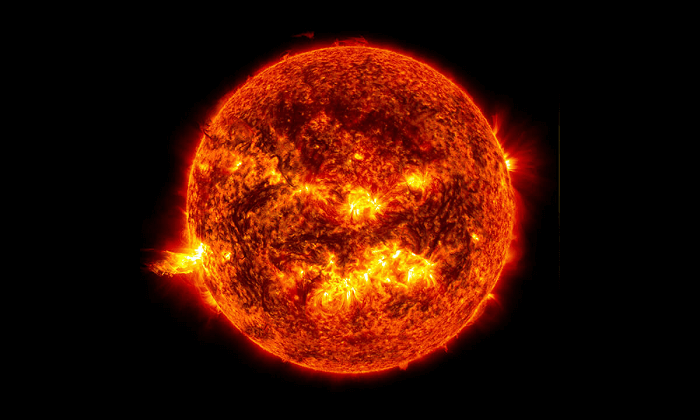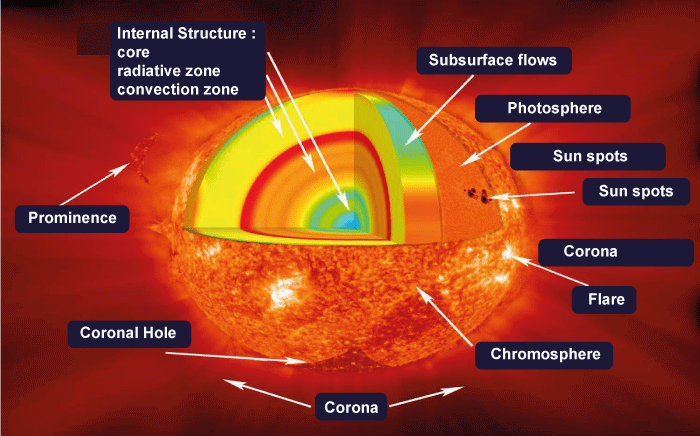Sun DefinitionThe Sun is the primary star in the Solar System. It is a nearly perfect ball of hot plasma heated by nuclear fusion processes to luminescence at its center. The Sun, the most essential energy source for life on Earth, emits this energy primarily as light, ultraviolet, and infrared radiation. 
The Sun's radius is around 109 times greater than Earth's at 695,000 kilometers (432,000 miles). Its mass is roughly 330,000 times that of the Earth, making up 99.86% of the entire Solar System. The Sun's mass is around three-quarters hydrogen (73%); the rest is primarily helium (25%), with considerably lesser amounts of heavier elements such as oxygen, carbon, neon, and iron. The Sun is a main-sequence G star (G2V). As a result, it is incorrectly and popularly referred to as a yellow dwarf (its light is white). It developed around 4.6 billion years ago due to the gravitational collapse of materials within an area of a massive molecular cloud. Most of this matter collected in the center, while the remainder flattened into the Solar System. The center mass grew so hot and dense that nuclear fusion began in its core. The majority of stars are thought to have formed using this technique. Every second, the Sun's core converts 4 million tonnes of mass into energy by fusing 600 million tonnes of hydrogen into helium. This energy, which can take between 10,000 and 170,000 years to escape the Sun's core, generates light and heat from the Sun. The density and temperature of the Sun's body will increase noticeably when its core hydrogen fusion has dropped to the level where it is no longer in hydrostatic equilibrium. The Sun finally turns into a red giant as its outer layers grow simultaneously. Earth will become uninhabitable in five billion years when the Sun enlarges to the point where its current orbits of Mercury and Venus are swallowed up. After that, it will lose its outer layers and transform into a white dwarf, a dense cooling star that no longer produces energy through fusion but still glows and emits heat from its earlier fusion. Since the beginning of recorded history, people have recognized the Sun's enormous impact on Earth. The Sun was worshipped as a god in some cultures. The Earth's synodic rotation and orbit around the Sun are the foundation for several solar calendars. The most popular calendar in use today is the Gregorian calendar, which was founded on the common understanding that the Sun's visible movement was natural in the 16th century. Physical FeaturesThe Sun is 215 R away from Earth, despite having a radius 109 times that of the planet. It, therefore, occupies a very small angle in the sky?just 1/2�?nearly the same as the Moon. In contrast, Proxima Centauri, the next star from Earth, is 250,000 times farther away, which reduces its actual brightness by the square of that ratio, or 62 billion times. The Sun's surface is so hot that neither solids nor liquids can exist there; instead, the Sun's surface is largely made of gaseous atoms and a few molecules. There is, therefore, no permanent surface. Most of the light visible to humans from Earth originates in the photosphere; radiation from lower layers is absorbed and reradiated, whereas emission from higher layers rapidly decreases by a factor of six every 200 kilometers (124 miles). The slightly cloudy surface cannot be resolved due to the Sun's great distance from Earth, but the limb (visible edge) appears crisp. The mass of the Sun is 330,000 times larger than Earth's and 743 times greater than the sum of the planets' masses in the solar system. The Sun's gravitational force dwarfs the exciting planetary and interplanetary gravitational events. The Sun's enormous mass pulls inward under gravity; therefore, to prevent the star from collapsing, the center pressure outward must be sufficient to support its weight. The Sun's core has a density of approximately six times that of the Earth's core and roughly 100 times that of water, yet it is at a temperature of at least 15,000,000 K. As a result, the central pressure is at least 10,000 times greater than the 3,500 kilobars of pressure at the Earth's core. Atomic nuclei completely stripped of their electrons collide at this extreme temperature to produce the nuclear reactions that produce the energy needed for life on Earth. The temperature of the Sun decreases from 15,000,000 K in its core to 5,800 K in the photosphere, but an unexpected reversal happens above that point; the temperature reduces to a minimum of 4,000 K and then starts to rise in the chromosphere, a layer that is roughly 7,000 kilometers high and has an average temperature of 8,000 K. In a total eclipse, the chromosphere appears as a pink ring. The corona is a 1,000,000 K-hot, black halo that surrounds the chromosphere and reaches well beyond the planets. Beyond a distance of 5R from the Sun, the corona expands outward at a rate of 400 kilometers per second (km/s) (near Earth); this rush of charged particles is called the solar wind. The Sun is a relatively consistent energy source; its radiative output, known as the solar constant, at Earth is 1.366 kilowatts per square meter and changes by less than 0.1 percent. This steady star, however, is accompanied by an intriguing 11-year cycle of magnetic activity expressed by patches of transitory high magnetic fields known as sunspots. Evolution of SunFor 4.6 billion years, the Sun has been blazing. In the core, where the burning is the fastest, a significant amount of hydrogen has been converted to helium. Helium is left behind because it absorbs radiation more readily than hydrogen. It boosts the center's temperature and brightness. According to model estimates, the Sun becomes 10% brighter per billion years. Therefore, it must be at least 40% brighter than when planets formed. It would result in a rise in Earth's temperature, yet there is no evidence of this in the fossil record. The greenhouse effect and cloudiness most likely offset thermostatic influences in Earth's atmosphere. The infant Sun may have been more massive and bright, but it would have lost its early bulk due to the solar wind. The rise in solar brightness is predicted to continue as the core's hydrogen depletes and the zone of nuclear burning expands. The fact that tidal friction will slow Earth's rotation until it equals the Moon's rotation, revolving once every 30 days in four billion years, is at least as important for the planet's future. The Sun's development should follow the same trajectory as most stars. When the core hydrogen depletes, nuclear burning will occur in an expanding shell around the depleted core. The principal will continue to shine brighter, and when the burning reaches the surface, the Sun will enter the red giant phase, forming a gigantic shell that may reach Venus or possibly Earth. Fortunately, unlike more massive stars that have already attained this state, the Sun will take billions of years. 
Solar AtmospherePhotosphereWhile no flames are on the Sun's surface, the photosphere seethes and roils due to the underlying convection. Photons trapped by the underlying layers ultimately emerge from below. It causes a significant reduction in temperature and density. The temperature near the visible surface is around 5,800 K, but it dips to approximately 4,000 K around 500 kilometers above the photosphere. Every 150 kilometers, the density, approximately 107 grams per cubic centimeter (g/cm3), decreases by 2.7. By most definitions, the solar atmosphere is a vacuum; the entire density above every square centimeter is around 1 gram, which is about 1,000 times less than the similar mass in Earth's atmosphere. The Earth's atmosphere can be seen through, but not the Sun's, because the former is shallow, and the molecules absorb only energy outside the visible range. In contrast, the heated photosphere of the Sun includes an ion known as negative hydrogen, H, which is a hydrogen nucleus with two electrons attached. Over the majority of the spectrum, the H ion absorbs light voraciously. The photosphere is the area of the Sun that can be viewed in normal light. Its picture exhibits two prominent features: limb darkening, a darkening towards the outermost regions, and granulation, a thin rice-grain-like structure. The darkening is caused simply by a drop in temperature; when one stares at the edge of the Sun, one sees the light from higher, colder, and more distant sources. Granules are convective cells that transport energy from below. Each cell is approximately 1,500 kilometers wide. Granules have a lifespan of around 25 minutes, during which heated gas rises roughly 300 meters per second at velocities. They then disintegrate by fading out or bursting into a ring of grains. Granules may be found all around the Sun. The explosion pattern is thought to form the surrounding granules in a practice known as degranulation. However, it needs to be determined whether or not such a pattern exists. A network of outward velocity flows, over 30,000 km across, most likely connected to the large convective zone rather than the comparatively small granules that make up the more significant, undeniable design known as supergranulation. The flow concentrates the surface magnetic fields to the supergranulation cells' boundaries, creating a web of magnetic field components. The supergranular pattern dominates the conducting gas in the atmosphere, where the magnetic fields of the photosphere extend. Although it still drops, the temperature above the average surface area does not drop as quickly as at the network edges. The network edges are bright on photographs of the Sun taken at a wavelength somewhat absorbed above the surface. In UV light, it occurs frequently. Research of the SunFraunhofer was the first to examine the sun spectrum, discovering emission in all colors and several dark lines at specific wavelengths. He gave letters to these lines, some still known today, such as the sodium D-lines, the G-band, and the ionized calcium K-lines. However, the German scientist Gustav R. Kirchhoff revealed the lines' meaning, which noted that the black lines developed in colder top layers, absorbing light from below. We can identify the elements responsible and their states of ionization and excitation by comparing these lines to laboratory data. The spectral lines detected are projected to be frequent at 6,000 K when each particle has a thermal energy of around 0.5 volts. At this temperature, the most abundant elements, hydrogen, and helium, are difficult to excite, but atoms like iron, sodium, and calcium contain numerous easily excited lines. When Cecilia Payne, a British-born graduate student at Harvard College Observatory in Cambridge, Massachusetts, U.S., discovered the tremendous quantity of hydrogen and helium in 1925, her seniors convinced her to disregard the discovery; only afterward was the truth revealed. The brightest lines in the visible spectrum are the ionized calcium H- and K- (Fraunhofer's letters) lines. It occurs because calcium is easily ionized, and these lines indicate transitions in which ions absorb energy in the ground, or lowest point, state. Because excitation is lacking in the photosphere and higher up, where atoms are only illuminated from below, electrons tend to fall to the ground state. Because most sodium is ionized and does not absorb radiation, sodium D-lines are weaker than Ca K lines. The intensity of the lines is governed by the amount and state of ionization of the specific element and the excitation of the atomic energy level involved in the bar. Working backward, one may calculate the abundance of most features in the Sun. This surplus occurs with extraordinary regularity across the cosmos; they may be found in quasars, meteorites, and budding stars. The Sun is around 90% hydrogen and 9.9% helium by atomic number. The remaining atoms are heavier elements, namely carbon, nitrogen, oxygen, magnesium, silicon, and iron, accounting for barely 0.1 percent of the total.
Next TopicTender Definition
|
 For Videos Join Our Youtube Channel: Join Now
For Videos Join Our Youtube Channel: Join Now
Feedback
- Send your Feedback to [email protected]
Help Others, Please Share










